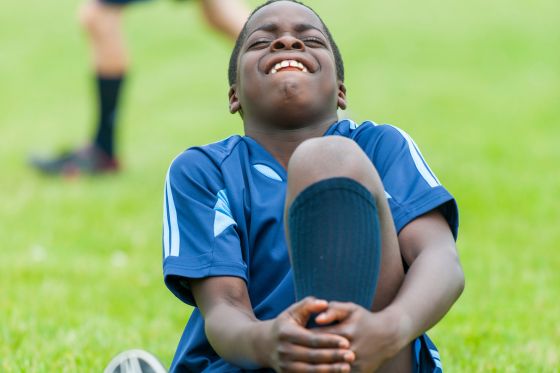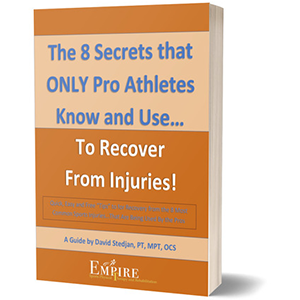The rush of adrenaline when you score, the triumphant highs of victory, and the togetherness of teamwork – soccer can offer some of life’s most exhilarating moments.
But perhaps you find yourself here because a season-ending injury has sidelined you, or maybe the fear of injury is casting a shadow over your game.
I want you to know that you’ve come to the right place, and I’m here to help.
At Empire Sports Physical Therapy & Rehabilitation, we understand the physical and emotional toll that sports injuries can take.
This blog aims to arm you with knowledge and preparation, outlining the five worst soccer injuries and offering proactive strategies to dodge the injury bullet and keep you playing the game with heart and freedom.
Understanding Soccer Injuries
Soccer injuries are often seen as an inevitable part of the game – a risk that comes with the territory. But why do they happen, and what impact can they have?
Injuries in soccer frequently result from a combination of factors such as overuse, improper technique, and inadequate conditioning.
High-impact collisions, sudden changes in direction, and repetitive stress can all contribute to these injuries.
Physically, they can lead to chronic pain, decreased mobility, and the dreaded forced hiatus from the sport.
Psychologically, the impact can be equally debilitating, leading to decreased confidence, fear of re-injury, and in some cases, the end of a sporting passion.
The 5 Worst Soccer Injuries and How To Avoid Them
ACL Tear or Strain
An ACL tear or strain is one of the most dreaded injuries in soccer. The anterior cruciate ligament (ACL) is crucial for stabilizing the knee joint, and injuries to it can occur during sudden stops, pivots, or awkward landings.
Such movements are common in soccer, where rapid changes in direction are part of the game.
To prevent an ACL injury, it’s essential to focus on strengthening the muscles around your knee, particularly the quadriceps and hamstrings.
These muscles provide critical support to the knee and help absorb the shocks that can otherwise damage the ligament.
Agility drills, such as plyometrics, can also enhance your coordination and neuromuscular control, making your movements more precise and less likely to result in injury.
Proper technique in jumping and landing is another vital aspect.
Learning how to decelerate safely can significantly reduce the impact forces on your knees, thus lowering the risk of an ACL tear.
Hamstring Strain
Hamstring strains are a common hazard in soccer, largely due to the sport’s demands for constant sprinting and sudden changes in speed.
The hamstrings, located at the back of your thighs, are particularly vulnerable to strains and tears when they are not adequately prepared for such intense activity.
To build strength and resilience in these muscles, incorporate eccentric exercises like Nordic hamstring curls into your training regimen.
These exercises focus on the lengthening phase of muscle contraction, which is crucial for developing durability.
Ensuring a thorough warm-up with dynamic stretches that target the hamstrings is also critical. This prepares the muscles for the demands of the game and reduces the likelihood of injury.
Additionally, maintaining muscle elasticity through regular flexibility training is essential.
Flexible muscles are less prone to strains and can better handle the rigors of soccer.
Ankle Sprain
Ankle sprains, which occur when the foot turns inward, stretching or tearing the ligaments on the outside of the ankle, are among the most common injuries in soccer.
These injuries often happen during quick changes in direction or when landing awkwardly.
To prevent ankle sprains, balance training is key.
Proprioceptive exercises, such as using balance boards, can enhance your ankle stability and improve your neuromuscular control, making it less likely that you’ll roll your ankle.
Strengthening the muscles around the ankle with exercises like calf raises and resistance band workouts is also crucial.
These exercises build the muscular support needed to protect the ligaments.
Additionally, wearing well-fitted, supportive shoes that provide adequate ankle support can significantly reduce the risk of sprains by keeping your foot in a stable position during play.
Groin Pull
Quick lateral movements or sudden changes in direction can cause groin pulls, a common injury in soccer that can sideline even the most seasoned players.
Preventing this injury involves a combination of dynamic stretching and strength training.
Incorporate lunges and butterfly stretches into your warm-up routine to prepare the groin muscles for the demands of the game.
Additionally, focus on resistance training for the inner thighs, such as side leg lifts.
These exercises help build muscle resilience, making the groin less susceptible to strains.
It’s also important to avoid sudden increases in activity intensity.
Gradually progressing your training allows your muscles to adapt and strengthens them over time, reducing the likelihood of a groin pull.
Concussion
A concussion, resulting from a collision or a blow to the head, is a serious concern for soccer players.
The impact can lead to a traumatic brain injury that affects your cognitive functions and overall health. To prevent concussions, strict adherence to head protection rules is paramount.
Always use headgear that is properly fitted and designed for soccer. Additionally, learning and practicing techniques to avoid head collisions can reduce the risk of a concussion.
Educating yourself and your teammates on the early signs and symptoms of concussions is also crucial.
Prompt recognition and immediate medical attention can prevent further damage and aid in a quicker recovery.
Ensuring a culture of safety and awareness in your team can go a long way in mitigating the risks associated with concussions.
By understanding these common soccer injuries and taking proactive steps to prevent them, you can play with confidence and focus on the game you love.
Injuries don’t have to be an inevitable part of your soccer journey.
Don’t Let Sports Injuries Ruin Your Summer
As the green shoots of spring emerge and athletes like you are ready to burst into full stride, it’s crucial to step into the season equipped with the right injury-prevention strategies.
At Empire Sports Physical Therapy, we are your partners in this mission, ensuring that your performance is your health are protected.
Let us be your guide in navigating the common mistakes that lead to soccer injuries.
We’re here to provide the support and expert advice you need to excel without the worry of injury.
To stay ahead of injuries and keep your game strong, download our Free Injury Prevention Report filled with valuable tips for soccer players.
You can also book a Free Telephone Consultation with our expert team to address your concerns and lay out a plan to enhance your athletic prowess while sidestepping injuries.
If you’re ready to take the next step, you can come and see us for a Free Discovery Visit at our physical therapy clinic in Rockland County and find out how we can help you recover from or prevent injuries.
Don’t let an injury bench you for the season. An injury plan is essential to ensure you’re not sidelined for an extended period.
Whether you’re recovering from an injury or aiming to prevent one, we’re your go-to resource for returning to your peak form through the power of physical therapy.
Join us and take control of your athletic destiny as we gear up for a season of victory and vitality.
More Free Advice For Common Sports Injuries
If you want to get more tips and advice on injury prevention, you can follow us on social media and read our expert articles.
Follow us on Facebook and Instagram for more free tips and updates from our Rockland County physical therapy clinic.
Read our expert article to learn about Which Sports Have The Most Injuries? What You Need To Know
Spring Training: 5 Expert Tips To Safely Increasing Sports Activity Find out from our expert article.
Find The Best Rotator Cuff Exercises For A Rotator Cuff Tear in our expert blog.




